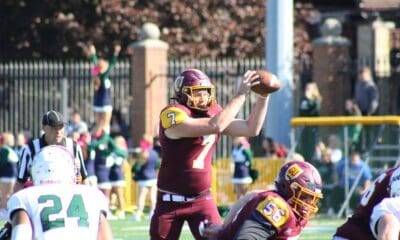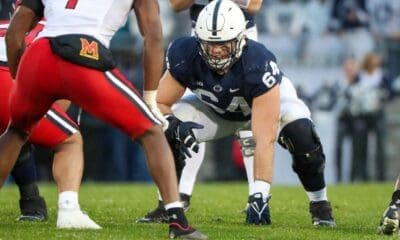Steelers Analysis
Farabaugh: Steelers Can’t Afford to Run Tires Off Najee Harris

Najee Harris had a great rookie year by most metrics. Putting up over 1600 yards from scrimmage, Harris was one of the most productive running backs in the NFL. While he was a key cog to the Steelers making the playoffs, there is one thing that sticks out about Harris’ season more than anything — his workload.
As a 23-year-old rookie running back, Harris’ workload was stunning. He led the NFL in touches with 381 touches over the 17-game NFL season. His 307 carries on the season were second to only star Indianapolis Colts running back Jonathan Taylor. Harris led the NFL among running backs in targets with 94 targets.
Those are just the surface stats for Harris’ frankly insane workload. It gets crazier from there. It showcases just how many touches Harris had on the season and just how unsustainable the workload actually is for Harris’ career.
Najee Harris Workload Versus the Rest of the NFL
The base stats above showcase a picture that Harris was heavily relied upon by the Steelers. That makes sense. Putting into perspective against the rest of the NFL shows just how stark a contrast Harris’ touches were compared to the rest of the league. Taylor came in a close 2nd with 372 touches compared to Harris’ 381. From there, the drop-off begins, with Cincinnati’s Joe Mixon at 334 touches and Washington’s Antonio Gibson coming in at fourth with 300 touches.
They were the only four running backs with 300 or more touches on the season. Of course, the pure touches argument is one thing, but players like Taylor and Mixon were on the field for less than 70% of their team’s snaps throughout the season. They both hovered right around 68% of the year. For a star running back, being on the field for two-thirds of the team’s snaps makes sense. Even then, Taylor and Mixon rank 5th and 7th, respectively, according to PlayerProfiler.
Unsurprisingly, it is Harris who leads the NFL with a whopping 85% snap share. David Montgomery of the Chicago Bears ranked 2nd with a 75% snap share. Derrick Henry, when he played this past season, had a snap share of only 71%. To put into perspective how crazy 85% is for a running back, when Henry had his monster 2020 season, he still only had a 66% snap share that year.
In other words, the average for an elite running back to play snap-wise is about two-thirds of a team’s snaps. Even if the drop-off from Henry to Jeremy McNichols was steep, Tennessee gave Henry a breather to keep him fresh and healthy. Playing on the field on 85% of snaps is a mind-blowing number. Mike Tomlin and the Steelers coaching staff went to Harris perhaps more than they should have.
Najee Harris is no Outlier in Pittsburgh
Harris’ 85% snap share is no outlier in the lore of Pittsburgh, either. Working back to 2016, the snap counts for Le’Veon Bell and James Conner paint a similar story. In 2016, Bell played a whopping 96% of snaps out of the backfield for the Steelers. In 2017, when Bell was on the franchise tag, that did not change much. He played on 91% of snaps for the Steelers that year, too. Those numbers led the NFL by far.
In 2018, when Conner was healthy, he racked up 80% of the team’s snaps out of the backfield. In 2019 and 2020, the Steelers lacked a true bell-cow and split up time between Conner, Benny Snell, and others. When Tomlin has a bell-cow running back, though, he metaphorically runs the tread off their tires.
So, Tomlin has historical precedence over Harris’ number. He has called Harris a bellcow time and time again. There is no denying the talent that Harris brings to the field. However, 85% is a ridiculous number that seems unlikely to change unless Tomlin wavers on what his history has shown.
What is the Next Move For Pittsburgh
Well, if this has to change, then who is going to play with Harris off the field? That might be the biggest question to answer in this entire scheme. One of the things that is most concerning here is the lack of a quality backup running back. Benny Snell only received 36 carries and put up a woeful 2.7 yards per carry figure. Anthony McFarland was injured and never got going. Kalen Ballage did very little outside of special teams’ work.
The point was the Steelers did not have someone they felt comfortable with moving forward. As was shown with Bell in the past, however, the Steelers and Tomlin make it known that when they have a workhorse running back, they use them in volume. Even when DeAngelo Williams and Conner backed up Bell, his snap share figure never dipped below 80%.
So, the Steelers need to change philosophy. They also need to sign a veteran running back. Those two things must happen. Running back is an incredibly physically demanding position. Even a running back like Harris should not be handling the workload he did in 2021. That is to prolong his career and stave off the injury bug. Pittsburgh was lucky Harris sported a clean bill of health for most of last season.
Running backs will break down with time. That naturally happens. The position is not one that carries lots of longevity with it. However, the guys that do have that longevity are either freak of nature or have a reduced snap share. If the Steelers want to get more quality years out of Harris and keep him healthy, his workload must decrease to ensure that happens.














